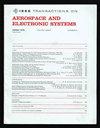四旋翼尾翼无人机的三维轨迹优化:穿越给定航路点
IF 5.7
2区 计算机科学
Q1 ENGINEERING, AEROSPACE
IEEE Transactions on Aerospace and Electronic Systems
Pub Date : 2025-01-20
DOI:10.1109/TAES.2025.3531845
引用次数: 0
摘要
当前固定翼自主飞行器(aav)的应用场景不断发展,要求其具备敏捷、快速的三维飞行能力。通常情况下,静尾机的飞行轨迹是为垂直飞行和水平飞行分别生成的。这限制了坐尾机在三维空间中移动的能力,并使其难以在垂直和水平飞行之间建立平稳过渡。本文提出了一种四旋翼坐尾机的三维轨迹优化方法。特别地,利用微分平面度法在生成坐尾机轨迹时消除了微分动力学约束。此外,使用最先进的轨迹生成方法MINCO(最小控制)生成轨迹的时间参数。随后,通过对轨迹进行时间离散,将对飞行器的速度约束转化为软约束。这增加了满足控制输入限制的可能性,并且轨迹是可行的。然后,我们利用一种模型预测控制方法来跟踪轨迹。即使将坐尾者的运动限制在二维水平面上,该解决方案仍然优于L1制导律和杜宾路径。本文章由计算机程序翻译,如有差异,请以英文原文为准。
Three-Dimensional Trajectory Optimization for Quadrotor Tail-Sitter AAVs: Traversing Through Given Waypoints
Given the evolving application scenarios of current fixed-wing autonomous aerial vehicles (AAVs), it is necessary for AAVs to possess agile and rapid 3-D flight capabilities. Typically, the trajectory of a tail-sitter is generated separately for vertical and level flights. This limits the tail-sitter's ability to move in a 3-D airspace and makes it difficult to establish a smooth transition between vertical and level flights. In this article, a 3-D trajectory optimization method is proposed for quadrotor tail-sitters. Especially, the differential dynamics constraints are eliminated when generating the trajectory of the tail-sitter by utilizing the differential flatness method. In addition, the temporal parameters of the trajectory are generated using the State-of-the-Art trajectory generation method called MINCO (minimum control). Subsequently, we convert the speed constraint on the vehicle into a soft constraint by discretizing the trajectory in time. This increases the likelihood that the control input limits are satisfied, and the trajectory is feasible. Then, we utilize a kind of model-predictive control method to track trajectories. Even if restricting the tail-sitter's motion to a 2-D horizontal plane, the solutions still outperform those of the L1 Guidance Law and Dubins path.
求助全文
通过发布文献求助,成功后即可免费获取论文全文。
去求助
来源期刊
CiteScore
7.80
自引率
13.60%
发文量
433
审稿时长
8.7 months
期刊介绍:
IEEE Transactions on Aerospace and Electronic Systems focuses on the organization, design, development, integration, and operation of complex systems for space, air, ocean, or ground environment. These systems include, but are not limited to, navigation, avionics, spacecraft, aerospace power, radar, sonar, telemetry, defense, transportation, automated testing, and command and control.

 求助内容:
求助内容: 应助结果提醒方式:
应助结果提醒方式:


